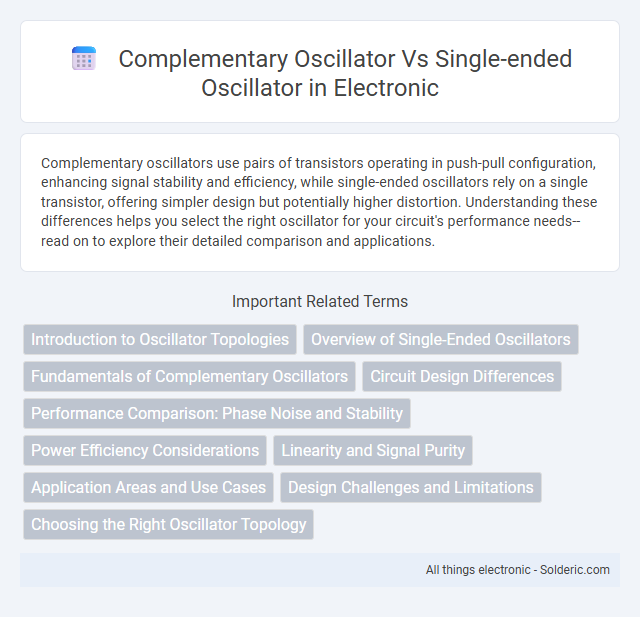Complementary oscillators use pairs of transistors operating in push-pull configuration, enhancing signal stability and efficiency, while single-ended oscillators rely on a single transistor, offering simpler design but potentially higher distortion. Understanding these differences helps you select the right oscillator for your circuit's performance needs--read on to explore their detailed comparison and applications.
Comparison Table
| Feature | Complementary Oscillator | Single-Ended Oscillator |
|---|---|---|
| Topology | Uses both NMOS and PMOS transistors | Uses only one type of transistor (NMOS or PMOS) |
| Power Consumption | Higher due to dual transistor operation | Lower, simpler transistor usage |
| Signal Swing | Larger voltage swing, closer to power rails | Smaller voltage swing, limited by transistor threshold |
| Output Symmetry | More symmetric output waveform | Asymmetric waveform, more distortion |
| Complexity | More complex circuit design | Simpler design, fewer components |
| Phase Noise | Generally lower phase noise | Higher phase noise due to asymmetry |
| Applications | High-performance RF circuits, clock generation | Low-power, low-frequency applications |
Introduction to Oscillator Topologies
Complementary oscillator topologies utilize pairs of transistors operating in push-pull configurations to enhance power efficiency and signal symmetry, making them ideal for high-frequency and low-distortion applications. Single-ended oscillators rely on a single transistor or active device, offering simpler design and easier implementation but often exhibit higher distortion and lower efficiency. Understanding these fundamental differences aids in selecting the optimal oscillator topology based on performance requirements and system constraints.
Overview of Single-Ended Oscillators
Single-ended oscillators use a single transistor or active device to generate oscillations, making them simpler and more energy-efficient for low-frequency applications. They typically have fewer circuit components, resulting in smaller size and reduced complexity compared to complementary oscillators, which employ both NPN and PNP transistors or their equivalents. Your choice of a single-ended oscillator is ideal when you need straightforward signal generation with minimum power consumption and circuit overhead.
Fundamentals of Complementary Oscillators
Complementary oscillators utilize a pair of transistors, typically one NPN and one PNP, working in tandem to generate a stable oscillation with improved linearity and reduced distortion compared to single-ended oscillators that rely on a single transistor. The push-pull arrangement in complementary oscillators allows for efficient power usage and symmetrical waveform output, making them ideal for high-fidelity signal generation in communication systems. Understanding these fundamentals helps you design oscillators with enhanced performance and reliability for your electronic applications.
Circuit Design Differences
Complementary oscillators utilize both NPN and PNP transistors or NMOS and PMOS devices in a push-pull configuration, enhancing power efficiency and reducing distortion. Single-ended oscillators rely on a single transistor or MOSFET as the active device, resulting in simpler circuit design but higher harmonic distortion and lower output power. The complementary topology demands more complex biasing and matching but offers improved linearity and drive capability compared to the single-ended design.
Performance Comparison: Phase Noise and Stability
Complementary oscillators typically exhibit lower phase noise due to balanced operation and reduced flicker noise compared to single-ended oscillators, which inherently suffer from higher noise levels and device mismatches. Stability in complementary designs is enhanced through symmetrical load conditions, reducing susceptibility to power supply variations and temperature fluctuations, whereas single-ended oscillators often show greater frequency drift under similar conditions. This makes complementary oscillators preferable for applications demanding high precision and low phase noise, such as RF communication and precision timing systems.
Power Efficiency Considerations
Complementary oscillators typically offer superior power efficiency compared to single-ended oscillators due to their balanced push-pull transistor configuration, which reduces power dissipation and improves signal integrity. Single-ended oscillators often consume more power because they rely on a single active device, leading to higher voltage swings and increased power loss. Your choice of oscillator should consider these efficiency differences, especially for battery-powered or low-power applications.
Linearity and Signal Purity
Complementary oscillators offer improved linearity by using both NMOS and PMOS transistors, reducing distortion and enhancing signal purity compared to single-ended oscillators that rely on one transistor type. Your choice of oscillator impacts the harmonic content, with complementary designs providing lower phase noise and cleaner output signals ideal for high-precision communication systems. Single-ended oscillators typically suffer from greater nonlinearities and increased harmonic distortion, which can degrade performance in sensitive applications.
Application Areas and Use Cases
Complementary oscillators are commonly used in RF communication systems and high-performance signal processing due to their improved frequency stability and reduced phase noise. Single-ended oscillators find application in low-power devices, simple clock generation, and basic timing circuits where circuit simplicity and minimal power consumption are crucial. Your choice between these oscillators depends on the required signal purity, power constraints, and the complexity of the intended application.
Design Challenges and Limitations
Complementary oscillators face design challenges such as increased circuit complexity and careful device matching to minimize phase noise and distortion, which can limit integration density and power efficiency. Single-ended oscillators are simpler but suffer from higher noise susceptibility and imbalance issues, constraining their performance in high-frequency applications. Your choice depends on trade-offs between noise performance, power consumption, and implementation complexity specific to your circuit requirements.
Choosing the Right Oscillator Topology
Selecting the right oscillator topology depends on application-specific requirements such as phase noise, power consumption, and complexity. Complementary oscillators offer improved linearity and reduced flicker noise by using both NMOS and PMOS transistors, making them suitable for low-noise RF circuits. Single-ended oscillators consume less area and are simpler to design but typically exhibit higher phase noise and lower linearity, favoring applications with relaxed performance constraints.
Complementary oscillator vs Single-ended oscillator Infographic

 solderic.com
solderic.com